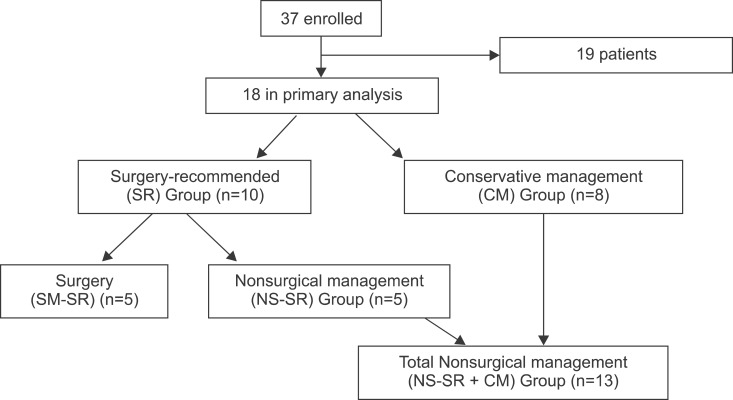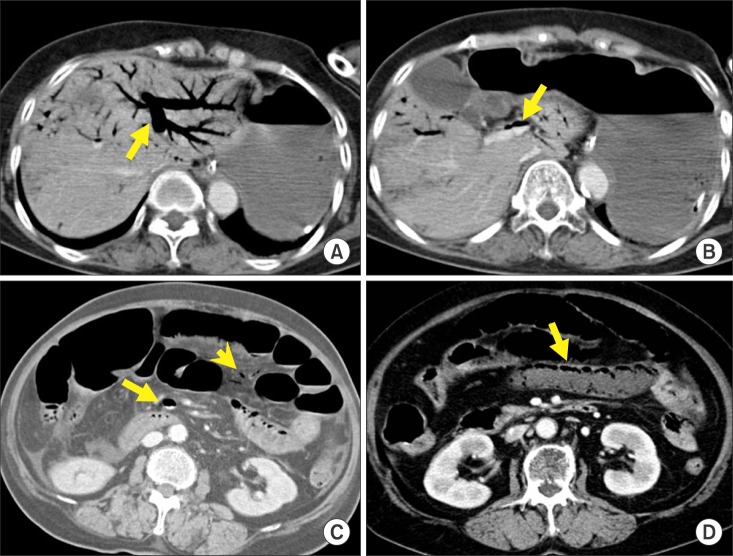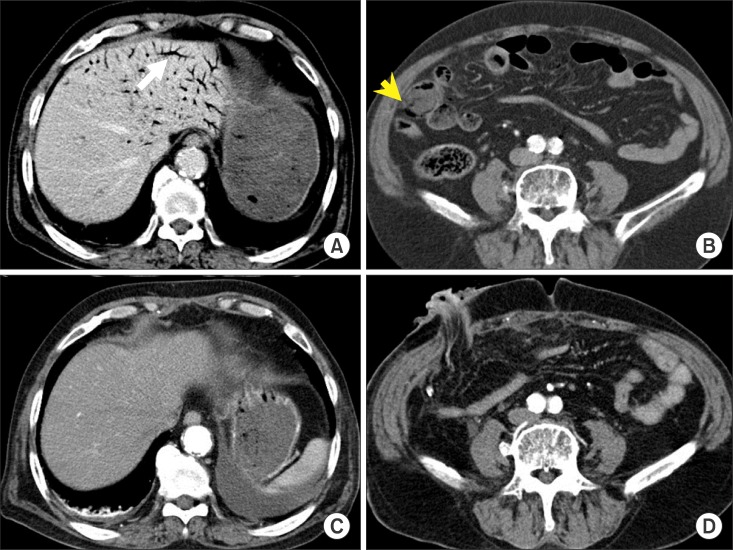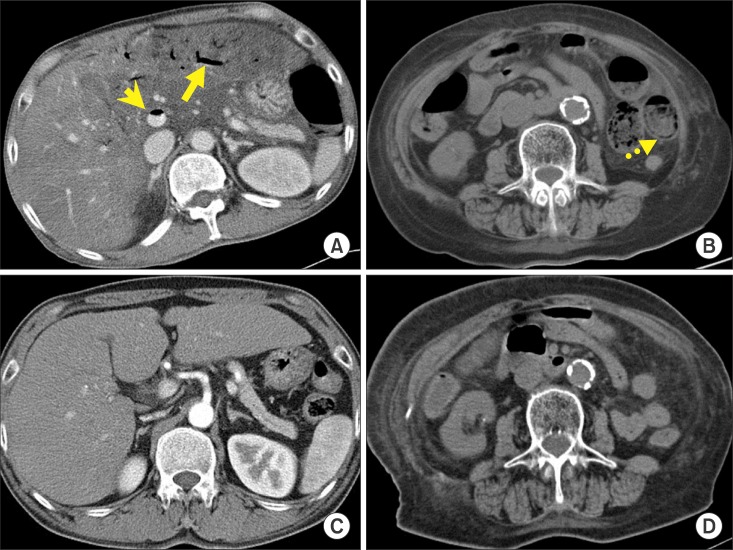Korean J Hepatobiliary Pancreat Surg.
2015 Nov;19(4):181-187. 10.14701/kjhbps.2015.19.4.181.
Clinical outcomes in surgical and non-surgical management of hepatic portal venous gas
- Affiliations
-
- 1Department of Surgery, Daegu Fatima Hospital, Daegu, Korea. lovehwik@daum.net
- KMID: 2130971
- DOI: http://doi.org/10.14701/kjhbps.2015.19.4.181
Abstract
- BACKGROUNDS/AIMS
Hepatic portal venous gas (HPVG) is a rare condition, with poor prognosis and a mortality rate of up to 75%. Indications for surgical and non-surgical management of HPVG including associated complications and mortality remain to be clarified.
METHODS
From January 2008 to December 2014, 18 patients with HPVG diagnosed through abdominal computed tomography (CT) imaging were retrospectively identified. Clinical symptoms, laboratory data, underlying diseases, treatment, and mortality rate were analyzed. Patients were classified into 2 groups: surgical management recommended (SR, n=10) and conservative management (CM, n=8). The SR group was further subdivided into patients who underwent surgical management (SM-SR, n=5) and those who were managed conservatively (NS-SR, n=5).
RESULTS
Conditions underlying HPVG included mesenteric ischemia (38.9%), intestinal obstruction (22.2%), enteritis (22.2%), duodenal ulcer perforation (5.6%), necrotizing pancreatitis (5.6%), and diverticulitis (5.6%). In terms of mortality, 2 patients (40%) died in the SM-SR group, 1 (12.5%) in the CM group, and 100% in the NS-SR group. Higher scores from Acute Physiology and Chronic Health Evaluation (APACHE) II predicted the mortality rates of the NS-SR and CM groups.
CONCLUSIONS
Identification of HPVG requires careful consideration for surgical management. If surgical management is indicated, prompt laparotomy should be performed. However, even in the non-surgical management condition, aggressive laparotomy can improve survival rates for patients with high APACHE II scores.
Keyword
MeSH Terms
Figure
Reference
-
1. Liebman PR, Patten MT, Manny J, Benfield JR, Hechtman HB. Hepatic-portal venous gas in adults: etiology, pathophysiology and clinical significance. Ann Surg. 1978; 187:281–287. PMID: 637584.2. Wolfe JN, Evans WA. Gas in the portal veins of the liver in infants; a roentgenographic demonstration with postmortem anatomical correlation. Am J Roentgenol Radium Ther Nucl Med. 1955; 74:486–488.3. Wu JM, Tsai MS, Lin MT, Tien YW, Lin TH. High APACHE II score and long length of bowel resection impair the outcomes in patients with necrotic bowel induced hepatic portal venous gas. BMC Gastroenterol. 2011; 11:18. PMID: 21385464.
Article4. Seak CJ, Hsu KH, Wong YC, Ng CJ, Yen DH, Seak JC, et al. The prognostic factors of adult patients with hepatic portal venous gas in the ED. Am J Emerg Med. 2014; 32:972–975. PMID: 25043627.
Article5. Iannitti DA, Gregg SC, Mayo-Smith WW, Tomolonis RJ, Cioffi WG, Pricolo VE. Portal venous gas detected by computed tomography: is surgery imperative? Dig Surg. 2003; 20:306–315. PMID: 12806196.
Article6. Nelson AL, Millington TM, Sahani D, Chung RT, Bauer C, Hertl M, et al. Hepatic portal venous gas: the ABCs of management. Arch Surg. 2009; 144:575–581. PMID: 19528392.7. Kinoshita H, Shinozaki M, Tanimura H, Umemoto Y, Sakaguchi S, Takifuji K, et al. Clinical features and management of hepatic portal venous gas: four case reports and cumulative review of the literature. Arch Surg. 2001; 136:1410–1414. PMID: 11735870.8. Abboud B, El Hachem J, Yazbeck T, Doumit C. Hepatic portal venous gas: physiopathology, etiology, prognosis and treatment. World J Gastroenterol. 2009; 15:3585–3590. PMID: 19653334.
Article9. Faberman RS, Mayo-Smith WW. Outcome of 17 patients with portal venous gas detected by CT. AJR Am J Roentgenol. 1997; 169:1535–1538. PMID: 9393159.
Article10. Monneuse O, Pilleul F, Barth X, Gruner L, Allaouchiche B, Valette PJ, et al. Portal venous gas detected on computed tomography in emergency situations: surgery is still necessary. World J Surg. 2007; 31:1065–1071. PMID: 17429565.
Article11. Hou SK, Chern CH, How CK, Chen JD, Wang LM, Lee CH. Hepatic portal venous gas: clinical significance of computed tomography findings. Am J Emerg Med. 2004; 22:214–218. PMID: 15138961.
Article12. Heye T, Bernhard M, Mehrabi A, Kauczor HU, Hosch W. Portomesenteric venous gas: is gas distribution linked to etiology and outcome? Eur J Radiol. 2012; 81:3862–3869. PMID: 22901713.
Article13. Morris MS, Gee AC, Cho SD, Limbaugh K, Underwood S, Ham B, et al. Management and outcome of pneumatosis intestinalis. Am J Surg. 2008; 195:679–682. PMID: 18424288.
Article14. Bodewes HW, Puylaert JB. Ultrasound in detection of portal venous gas in adults. Gastrointest Radiol. 1991; 16:35–37. PMID: 1991606.
Article15. Peloponissios N, Halkic N, Pugnale M, Jornod P, Nordback P, Meyer A, et al. Hepatic portal gas in adults: review of the literature and presentation of a consecutive series of 11 cases. Arch Surg. 2003; 138:1367–1370. PMID: 14662541.
- Full Text Links
- Actions
-
Cited
- CITED
-
- Close
- Share
- Similar articles
-
- Successful Conservative Management of Hepatic Portal Venous Gas due to Anastomosis Leakage After a Sigmoidectomy
- Portal Venous Gas after Insertion Umbilical Venous Catheter: A Case Report
- Iatrogenic Gastric Dilatation: A Rare and Transient Cause of Hepatic-portal Venous Gas
- A Case of Hepatic Portal Venous Gas Caused by Clostridium perfringens in a Patient with Mesenteric Atriovenous Malformation and Portal Hypertension
- A Case of Necrotizing Colitis Presenting with Hepatic Portal Venous Gas and Pneumatosis Intestinalis





